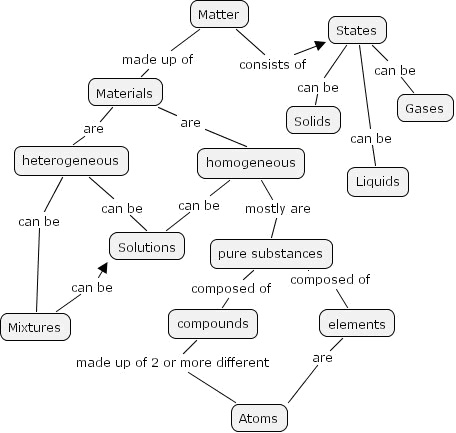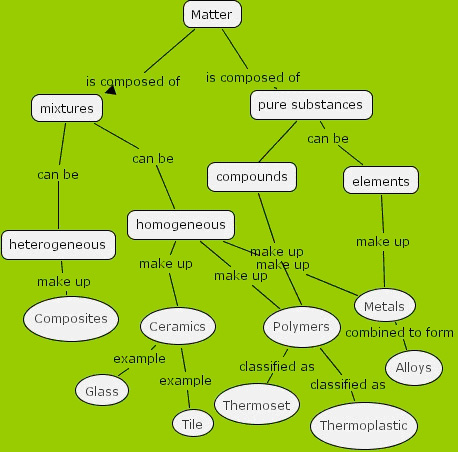
Return to the Professional Development Module Index
Printer Friendly Version
Grades: 5-8
Author: Jon Valasek
Module Description
In this lesson participating teachers will be led through an exercise to develop a scheme for classifying matter using the inquiry method. This is a lesson involves the cognitive skill of inquiry and the content skill of the classification of matter. No prior knowledge of classification of matter is necessary. This activity could be used to introduce concept mapping.
Engagement
Before giving materials to students to handle, remind them to exercise safe procedures. Introduce the lesson by passing out the items you have collected; one to each student. Ask, "Each one of these items is a piece of matter because? Solicit responses. (Answer is that matter has mass and occupies space.) Ask, "How would you describe your item?" Accept all responses. (Example: A student holds up an aluminum wire and states that it is solid, shiny, and the same throughout. List each response on the board. Give students an opportunity to look over all the responses. Ask, "Could we take these responses and organize them into categories?" After the students offer suggestions, say, "Look at all the entries on the board and group items that have the same thing in common." An example would be all things that are shiny and solid should be grouped together as "metals".
Assessment: Have the participants discuss their maps with other members of their group. Have each group come up with a consensus of the map that best represents the efforts of its members. Have one person from each group put their map on the board or butcher paper. The PPD should lead a discussion of the pros and cons of each map.
Exploration
Handout or put on the board a list of terms: matter, states, materials, heterogeneous, homogeneous, solids, liquids, gases, solutions, pure substances, element, atoms, and compounds. Take one of the objects and ask a series of questions that leads students to operationally define the terms. "Is this matter? What state is it? Is it uniform (homogeneous)? Is it an element? You are looking for descriptions that fit the ones in the Content knowledge section (see below). Then using these terms have the students develop a hierarchy of these terms. You might lead the students through the diagram or have them draw a concept map. See AGPA links.

Assessment: Have students share their maps with others in their group. Members of the group should perform self-assessment to agree on one concept map, which they will later share with the whole class.
Explanation
Have each group share their results with the entire class. State that we can categorize all matter by the use of this diagram but there is another scheme that is more practicable. It involves four categories metals, ceramics, polymers, and composites. Without defining each have the students place their object in one of the four categories and state the reasons for their selection. Note the student's selection on the board.
Assessment: After each object is placed ask if any should be moved. In summary ask for the definition for each category.
Elaboration
As a final exercise have the students take their object and integrate it into the diagram previously created. Note that the students must first integrate the four material categories into the diagram first, then place their object onto the diagram.

TAssessment: Check student's diagram for accuracy.
Teaching with inquiry can be defined as giving: "students ample opportunities to apply the reasoning and procedural skills of scientists while learning the principles and concepts of science along the way." Typically teachers use activities as a way to introduce students to new concepts. This activity is designed to aid participants in engaging their students in the process of classifying matter and then using everyday materials and then explore the composition of matter. Once the participant feels comfortable with this activity, he/she can guide his/her own students through the same process and allow them to become more independent and actively involved in their own learning processes.
Content, Technology, and Professional Development:
Content:
Science as Inquiry: as a result of activities, in grades 5-8, all students should develop
Professional Development Standards:
Standard A: Professional development for teachers of science requires learning essential science content through the perspectives and methods of inquiry. Science learning experiences for teachers must:
Standard B: Professional development for teachers of science requires integrating knowledge of science, learning, pedagogy, and students; it also requires applying that knowledge to science teaching. Learning experiences for teachers of science must
Preparation time: 20 minutes.
Lesson time: 45-60 minutes.
See Materials section.
Choose materials and solutions that are common household items and locally available. No special precautions are necessary.
Assessments are given after each part of the learning cycle in the procedures. If possible, visit the classes when the participants are using the simulations developed at the professional development.
Heterogeneous - is not uniform when examined by sight. Tree bark would be heterogeneous.
Homogeneous - is uniform when examined by sight. Unspoiled milk is homogeneous.
Materials can be heterogeneous or heterogeneous and are made up of the following categories:
Elements - A substance that cannot be broken down by physical or chemical means.
Compounds - A combination of two or more elements that can be broken down to elements.
None available for this module.
Writing: Learners may want to research how a particular material is made or used. See www.mii.org or www.howstuffworks.com for details.
Download Lesson Implementation Template: Word Document or PDF File
Be sensitive to gender, ethnic, and religious backgrounds when grouping.
N/A for this module.
This activity was adapted from one used by Doug Rummel in his 8th grade physical science class at St. Mark's School of Texas, 10600 Preston Rd. Dallas, TX 75230.